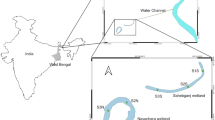Abstract
Much of the lake shore in Lake Victoria is covered by extensive wetlands, often dominated by dense papyrus stands that extend out over the lake waters. These wetlands, their extension and management play a role in the physical, chemical and biological conditions of the inshore waters. Continuous transects along 180 km of shoreline together with spatial grids of sampling sites in eight bays were performed in the Ugandan inshore waters in order to analyze the relationships between the wetland characteristics and water quality. Measurements of extension of the wetland ecotones, water temperature (T), pH, Secchi disk depth (SD), dissolved oxygen (DO), total nitrogen (TN), total phosphorous (TP), dissolved inorganic nitrogen (DIN), soluble reactive phosphorus (SRP) and chlorophyll-a (CHL) were made in each sampling area. Data of T, pH and DO collected during the transects showed that the water characteristics of the bays differ from the open shoreline. Moreover, the magnitude of these physical–chemical differences is strongly conditioned by the dimension of the bordering wetlands. Bays with extensive wetlands ecotones were characterized by cooler, more acidic and poorly oxygenated waters. TN : TP ratios and especially DIN : SRP ratios decreased with the wetland presence along the coastline, showing a higher probability of N limitation in the inshore waters where large wetlands are present. Results point to denitrification processes in the wetland ecotones as the cause of this trend. The distribution of CHL was found to be highest in the presence of two significant point loading sources: a river (in Katonga Bay) and a major population centre (Kampala, in Murchison Bay). The reduction of external P loading is shown as an important step in the management of the eutrophication process of Lake Victoria inshore waters.





Similar content being viewed by others
References
An S, Gardner WS, Kana T (2001) Simultaneous measurement of denitrification and nitrogen fixation using isotope pairing with membrane inlet mass spectrometry analysis. Appl Environ Microbiol 67:1171–1178
Albright T, Moorhouse T, McNabb T (2002) The abundance and distribution of water hyacinth in Lake Victoria and the Kagera River basin, 1989–2001. USGS/EROS Data Center and Clean Lakes, Inc., p 42
APHA, American Public Health Association (1992) Standard methods for the examination of water and wastewater, 18th edn. American Public Health Association, Washington, DC
Balirwa JS, Bugenyi FW (1988) An attempt to relate environmental factors to fish ecology in the lotic habitats of Lake Victoria. Verhandlungen der Internationalen Vereinigung für Limnologie 23:1756–1761
Bugenyi FWB (2001) Tropical freshwater ecotones: their formation, functions and use. Hydrobiologia 458:33–43
COWI consulting Engineers and Planners (2002) Integrated water quality/limnology study for lake victoria environmental management project, Part II Technical Report
Evans JH (1961) Growth of Lake Victoria phytoplankton in enriched cultures. Nature 189:147
Guildford SJ, Hecky RE (2000) Total nitrogen, total phosphorus and nutrient limitation in lakes and oceans: is there a common relationship?. Limnol Oceanogra 45:1213–1223
Hecky RE (1993) The eutrophication of Lake Victoria. Verhandlungen der Internationalen Vereinigung für Limnologie 25:39–48
Lund JWG, Kipling C, Le Cren ED (1958) The inverted microscope method of estimating algae numbers and the statistical basis of estimations by counting. Hydrobiologia 11:143–170
MacIntyre S, Romero JR, Kling GW (2002) Spatial-temporal variability in surface layer deepening and lateral advection in an embayment of Lake Victoria, East Africa. Limnology Oceanogr 47:656–671
Mugidde R (1993) The increase in phytoplankton primary productivity and biomass in Lake Victoria (Uganda). Verhandlungen der Internationalen Vereinigung für Limnologie 25:846–849
Mugidde R (2001) Nutrients status and planktonic nitrogen fixation in Lake Victoria, Africa. PhD Thesis. Univ. of Waterloo, Ontario, Canada, p 196
Muli JR (1996) Environmental problems of Lake Victoria (East Africa): what the international community can do. Lakes Reserv: Res Manage 2:47–53
Ochumba PB (1990) Massive fish kills within the Nyanza Gulf of Lake Victoria, Kenya. Hydrobiologia 208:93–99
Ogutu-Ohwayo R, Hecky RE, Cohen AS, Kaufman L (1997) Human impacts on the African Great Lakes. Environ Biol Fishes 50:117–131
Poe AC, Piehler MF, Thompson SP, Paerl HW (2003) Denitrification in a constructed wetland receiving agricultural runoff. Wetlands 23:817–826
Sturmbauer C, Meyer A (1992) Genetic divergence, speciation and morphological stasis in a lineage of African cichlid fishes. Nature 358:578–581
Smith VH (1983) Low nitrogen to phosphorus ratios favor dominance by blue-greenalgae in lake phytoplankton. Science 221:669–671
Talling JF (1966) The annual cycle of stratification and phytoplankton growth in Lake Victoria, East Africa. Internationale Revue der gesamten Hydrobiologie 50:1–32
Talling JF, Driver D (1963) Some problems in the estimation of chlorophyll a in phytoplankton: proceedings, Conference of Primary Productivity Measurement, Marine and Freshwater. Hawaii, 1961. U.S. Atomic Energy Commission TID-7633, Washington, DC, pp 142–146
Wetzel RG (1983) Limnology, 2nd edn. Saunders, Philadelphia, p 860
Witte F, Goldsmidt T, Goudswaard PC, Ligtvoet W, van Oijen MJP, Wanink JH (1992) Species extinction and concomitant ecological changes in Lake Victoria. Netherlands J Zool 214–232
Acknowledgments
This project is supported through the European Commission Directorate General XII INCO-DEV programme (ICA4-CT-2001-10036). We would like to thank Nicholas Azza for the fruitful collaboration and Prof. Patrick Denny for the comments and suggestions. The research was supported by the Italian Interuniversity Consortium CSGI.
Author information
Authors and Affiliations
Corresponding author
Rights and permissions
About this article
Cite this article
Cózar, A., Bergamino, N., Mazzuoli, S. et al. Relationships between wetland ecotones and inshore water quality in the Ugandan coast of Lake Victoria. Wetlands Ecol Manage 15, 499–507 (2007). https://doi.org/10.1007/s11273-007-9046-6
Received:
Accepted:
Published:
Issue Date:
DOI: https://doi.org/10.1007/s11273-007-9046-6




